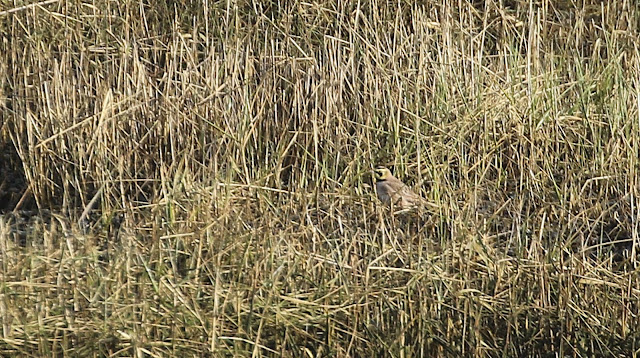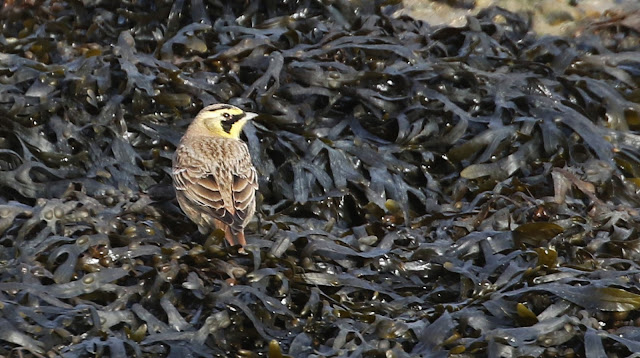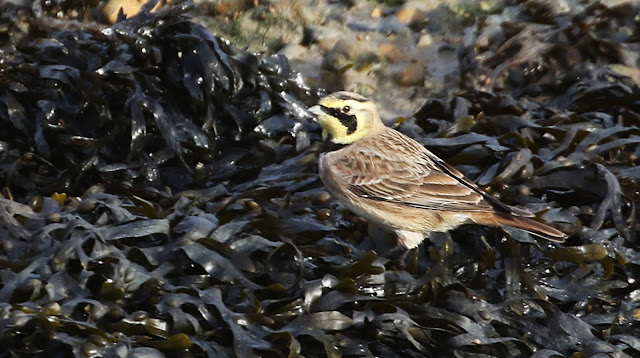I was up before dawn for the first time in awhile and heading west before 7:00 am, it is still quite dark in the morning. I was heading for the a stretch of pebbles and saltmarsh that stretches from Milford-on-Sea to Hurst Castle, formaly known as Hurst Spit. On the way I encountered a Barn owl hunting the central reservation of the A31 by Gander Down, the first time I had see one here. I parked alongside the many RVs along New Lane, crossed Cut Bridge and set off along the pebble track in the direction of the castle
It was cold, damp and overcast, but not the freezing weather of the past week, the forecast was for sunshine later in the day. The tide was low and there were plenty of waders, mostly Dunlin, Ringed Plover and Turnstones feeding on the mud and bladder wrack washed up on the shore. There were also Wigeon, Teal and plenty of Pintail. Every so often the duck and waders would spook and fly around before settling back on the water.
A lone drake Wigeon
I walked along the bottom of the spit on the saltmarsh side and aside from disturbing Turnstone and Dunlin there was no other bird life to be seen.
I reached the point where the open water channel turned away fro the spit and climbed the bank to the top. From here I could see both sides. The sea towards the Needles was dead still, mill pond calm but with no birds. Excitement was raised when a Cormorant flew in and these Pintail headed towards the straits that enter the Solent by Hurst Castle
It was a huge area and I was looking for a bird that was slightly smaller than a Skylark in this expanse of pebbles and salt marsh.
I had been here for just over an hour with no sign of any small birds. A large flock of Knot came in off the sea and headed east towards the mud flats.
One or two of the birders I had given up and left, down below a lone fisherman was spinning in the channel and was having about as much luck as I was having in my search for the bird. He, too, gave up, but decided to walk towards me and as he did so I noticed two birders top and raise their binoculars and point. I scanned the area where they were looking and a small brown bird flew out and with a smooth undulating flight took off and headed low over the shingle away from me. I watched as it finally came to rest amongst the tide line about 100 metres away.
I quickly made my way along the spit and managed to locate the bird feeding in amongst the sticks and weeds below me, a Shore Lark.
Not a new bird for me, but one I have struggled to find and see in the past and also a first in Hampshire. I walked along the beach at Leysdown on Sea on the Isle of Sheppey last year trying to find a group of seven without any luck, and have also searched around Holkham in Norfolk without success on numerous occasions, so it was wonderful to get to see this bird and the last two hours were now all forgotten.
It was known to be quite flighty so I took the opportunity to take as many photographs as I could as it searched and found seeds amongst the rubbish in the shingle and pebbles
As
the name suggests, in the United Kingdom Shore Larks are usually seen on the
coast, where they favour saltmarshes and shingle shores. Most records come from
the east coast of England. Shore Lark numbers can vary dramatically - some
winters might see only a few birds in the whole of the UK, while in exceptional
years there can be hundreds.
Then it was off, flying across the water and over to the salt marsh on the other side, there was concern amongst the gathered birders that it would disappear but it was located feeding amongst the grasses and at time out in the open on the sandy parts, but at all times distant. You can just make it out here in the grass, the binocular view

Then a cropped image
The news was out and birders started to arrive and the constant discussion was on how to get on to the Shore Lark, and it seemed most were happy with the views. We waited in hope it would come back and were entertained by a very punky male Red-breasted Merganser.
A Little Egret and two Cormorants were close by and agitated the merganser, raising quite an impressive crest.
Having got away from the attention it settled down.
The weather was changing, the cloud was breaking up and a shaft of sunlight was picking out the chalk cliffs on Studland.
The cloud formations looking west.
And looking east across the saltmarsh.
The Shore Lark continued to show in amongst the grass, but still on the other side of the channel.
Time dragged on and many birders opted to walk away. Then the Shore Lark flew to an open part of the marsh.
Then it flew across the channel over the spit and on to the beach on the other side. It was picked up just behind one of the ridge.
It then moved across the shingle.
From the beach it then flew across the spit and down onto the bladder wrack below me.
The Shore Lark population that visits the UK has declined
rapidly in recent decades, possibly as a result of overgrazing on their
breeding grounds. Though still present
in small numbers most winters, the species’ British decline is mirrored in its
Scandinavian home territories, possibly due to changes in farming practices.
This loss is made more melancholic by the realisation that the species is actually
one of our more intriguing winter migrants, that warrants a good deal more
attention from birders.
Gradually, by creeping along the spit, I was able to get closer.
Shore Lark is possibly the most distinctive European
representative of the highly adaptable lark family, Alaudidae. It is found
widely across much of the northern hemisphere, even penetrating into South
America, with a relict subspecies in Colombia. Large and variably distinct
populations are found across the Central Asian steppes and the Himalayas, and
at its southern extent it also reaches into Mexico and Morocco. It is the only
lark found in the New World, having spread there at least 600,000 years ago,
and the only member of its family to colonise alpine, tundra and grassland
habitats, from sea level up to 5,400 m.
From the sea weed t flew to the rubbish on the tide line.
Depending on where the bird is found, the cheeks, forehead,
supercilium and throat range from white to yellow. The entire underparts are
white, while the upperparts are more cryptic, being either streaked grey-brown
or plain and sandy-brown, depending on habitat. Shore Lark is a touch smaller
than Skylark, with a longer tail and shorter bill.
The flight is gently undulating and in doing so it shows the
tail with a distinctive arrangement of white outer feathers bordering two acute
black triangles, surrounding a brownish rump.
Northern Holarctic birds are migratory, but southern forms
are largely sedentary, undertaking altitudinal migration or local dispersal at
best. Prolonged northern snowfall appears to be the initiating mechanism for
migration, and the species will form small casual flocks, as either a response
to the clumped distribution of edible seeds or for protection against
predators.
Shore Lark largely consumes seeds in winter and insects in
summer, happily chasing the more mobile items by walking, running or
hopping.
The American name for Shore Lark, Horned Lark, is actually
more appropriate, as only the northern Eurasian
subspecies flava regularly winters in coastal habitats, while the
species’ most obvious feature is its ‘horns’, formed by two pointed black feathers
jutting out backwards on either side of the crown, most prominently in males.
Slightly smaller than a skylark, with a distinctive head pattern. They have a
yellow face with a black bib, eye mask and band at the front of the crown.
One of the horns is just visible in these two photographs.
The bird was still flighty, but fortunately it was heading back towards the car parks.
Depending on latitude, breeding occurs between mid-May and
mid-July in the north, but may begin as early as mid-February in southern arid
populations. Shore Larks can have one to three broods with two to seven eggs,
generally increasing from north to south. Chicks hatch after 10 to 14 days of
incubation, naked and defenceless, and are fed by both parents before fledging
after nine to 12 days; they fly after 16 to 18 days. Like many ground-feeding
birds, they learn to run before they can fly. Mortality is largely due to
predation, but they are also parasitised by Brown-headed Cowbird in North
America.

A little-known behavioural quirk is that the more northerly
American forms habitually dig roosting tunnels in snow up to 30 cm in depth,
with a ‘bed chamber’ at the end. Similar behaviour is exhibited in some desert
forms – the subspecies ammophila from the Mojave Desert has been observed
digging roost holes in the sand behind vegetation. Such behaviour decreases
energy loss and risk of predation at night by reducing the exposed body surface
area.
From the shingle it flew back to the bladder wrack.
The last confirmed British breeding pair was in 2003, after
more regular breeding in the north and west Highlands of Scotland ceased in
1977. Britain’s familiar coastal
wintering form, flava, has rapidly declined since the 1950s. Though
possibly attributable to overgrazing on its breeding territories, although this
is not proven.
Then it flew off across the channel and back to the saltmarsh.
I decided it was time to move on but on reaching the bridge decided to walk a little further towards Sturt Pond. There were a lot of walkers about, enjoying what was now a pleasant day. A Little Egret sat attentively on the other side of the stream in the sunshine.
With all the numbers of people about it was a pointless exercise so I headed back to the car. A Raven has learnt to hang around the bridge area, I missed it earlier and on returning to the car it was sat in the field eating something.
It was time to move on, the remainder of day will be subject of another blog post.





























































No comments:
Post a Comment